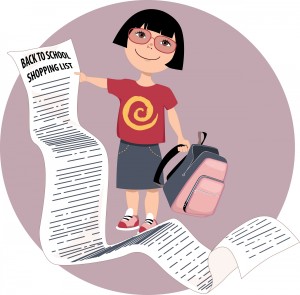 Contact Peggy Olive, 608-262-6766, polive@wisc.edu
Contact Peggy Olive, 608-262-6766, polive@wisc.edu
With fall just around the corner, school supply lists are starting to appear in stores among the rows of bright colored folders, notebooks, pens and pencils.
According to the National Retail Federation, the average family plans to spend around $630 this fall. School supplies account for about $100 of this budget, with additional purchases including clothing, shoes and small electronics.
“That’s almost as much people spend for the winter holidays,” says Peggy Olive, financial capability specialist with the University of Wisconsin-Extension/Madison. “Many households set aside money year round to help cover their holiday expenses, but back-to-school time always seems to sneak up on us – and add up quickly.”
Tips to stretch your budget
Before you head out to the stores or get online, a little time spent planning can help to stretch the budget.
–First, go through school supplies and clothes from last year and list all of the items and clothes that you already have on hand. Does your child really need a new backpack, or a new lunchbox? Do the jeans from last year still fit?
–Also consider fees paid directly to the school, such as book rentals, band instrument rental or athletic fees, and required immunizations, and list these fixed costs in the “must have” category. Paying for lunch can also be surprisingly costly. Free and reduced-price school lunch programs through your school district can ease the pressure on the budget for eligible families.
–Next, figure out which items your child needs at the start of school and which items can wait a month or two. Maybe one or two pairs of new pants will make do for the start of school, especially if your child is going through a growth spurt. Waiting to buy some items until later fall and pre-season sales allows time for the child to grow and a chance to spread out spending.
–Then use your child’s school supply list, your school fees must-have list, and your list of needed clothes to come up with a total budget amount for each child in school.
–Finally, compare your budgeted amount with your monthly expenses. Are there places you can cut back on other bills to find back-to-school funds? What resources does your community have to help stretch your dollar? School districts frequently have information on school supply donations and clothing exchanges sponsored by local service organizations.
“Back-to-school shopping provides an opportunity to involve the kids in purchasing decisions, too,” adds Olive. “According to the National Retail Federation, pre-teens spent an average of $18 of their own savings, while teens spent around $33.”
Parents can explain that there are many options available for buying the things they need. For example, a pair of jeans might cost $40 at a stylish chain store; $20 at a retail department store; $8 at a thrift or resale shop; and $3 at a garage sale. School notebooks cost from 50 cents to over $5 depending on the style and design. Let kids check out a thrift store and look through store fliers to price and plan for items they might purchase.
If teens are using money they earned, parents can help them do the math on how many hours they need to work to pay for the items they want to buy. If they are earning $7.50 per hour at the local grocery store, they might take home about $4.50 per hour after taxes. It takes more than eight hours of work to be able to pay for a pair of $40 jeans.



